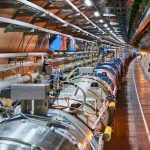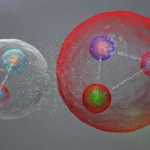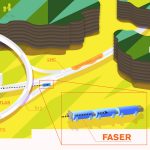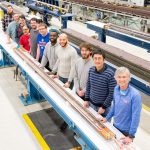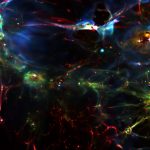It’s not always about what you discover. The LHC research program is famous for discovering and studying the long-sought Higgs boson. But out of the spotlight, scientists have been using the LHC for an equally important scientific endeavor: testing, constraining and eliminating hundreds of theories that propose solutions to outstanding problems in physics, such as why the force of gravity is so much weaker than other known forces like electromagnetism.
CERN
A re-examination of a particle discovered in 2015 has scientists debating its true identity. A recent analysis by the LHCb collaboration at CERN raises questions about the identity of this pentaquark—and may have taken scientists back to square one in the search for a particle that could shed light on questions about color.
A Swedish university tapped the founding director of CERN’s artist-in-residence program to curate a new art exhibit inspired by physics. The pieces are not literal translations of physics concepts to other media or illustrations of physics principles or phenomena. Physics was a spark for the artists, sometimes very clearly and sometimes more tangentially.
One day in 2017, the idea to detect particles that had potentially been escaping the LHC for years unnoticed by the gigantic detectors suddenly became feasible. The story of the latest experiment approved for installation at the Large Hadron Collider starts with a theorist and a question about dark matter.
The U.S. Department of Energy has approved the scope, cost and schedule for the U.S. LHC Accelerator Upgrade Project and has given the first approval for the purchase of materials. This project brings together scientists, engineers and technicians from national laboratories — such as Fermilab, Brookhaven, Berkeley, SLAC and Jefferson labs — to develop two cutting-edge technologies to advance the future of both the Large Hadron Collider and broader collider research.
From ZDNet, Feb. 20, 2019: A team at Switzerland-based research center CERN has rebuilt World Wide Web, the world’s first browser created in 1990 for its researchers.
From AAAS, Feb. 16, 2019: The Higgs boson, the once-elusive particle that provides mass to the building blocks of the universe, is the most famous product of the CERN international laboratory, but the lab’s bragging rights extend to a host of innovations, said the lab’s director-general Fabiola Gianotti.
With the warmth of holiday cheer in the air, some physicists decided to hit the pub after a conference in December 2014 and do what many physicists tend to do after work: keep talking about physics. That evening’s topic of conversation: dark energy particles. The chat would lead to a new line of investigation at the Large Hadron Collider at CERN. Every second, the universe grows a little bigger. Scientists are using the LHC to try to find out why.
From IEEE Spectrum, Jan. 30, 2019: If realized, the Future Circular Collider will produce magnetic fields nearly twice as strong as the LHC and accelerate particles to unprecedented energies of 100 teraelectron volts, compared to the Large Hadron Collider’s energies of 13 TeV. Whereas the magnetic system at the LHC can achieve strengths of 8.3 teslas, the FCC system would be able to achieve 16 T.

